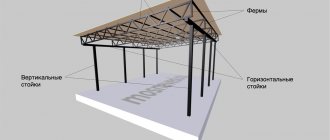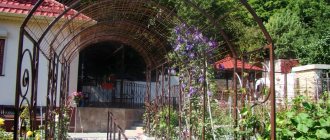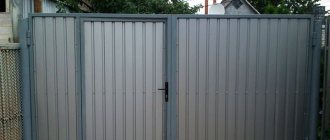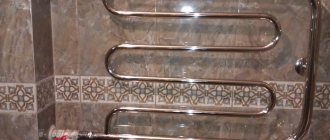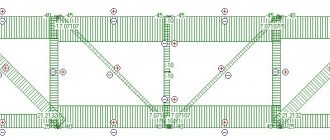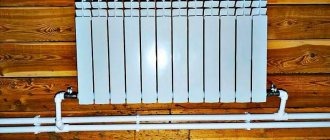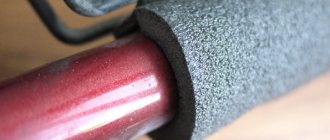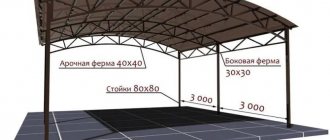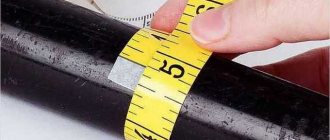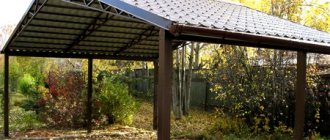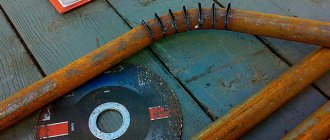Nowadays, protective structures in the form of a canopy made of profile pipes have become incredibly popular in household consumption. They can be found at almost every turn: recreation areas, sports grounds, parking lots, dachas, the private sector - all these places are most often equipped with these devices. The breadth of operation is determined by the factor of personal production - that is, if desired and the presence of the necessary skills, equipment and materials, the highway can be made independently. But in order to correctly build the frame, it is necessary to correctly make the appropriate calculations.
Single-pitch carport
Scope of application of structures
At the moment, household pipe structures based on metal profiles are the leading direction in the manufacture of frames and canopies with polycarbonate coating. Great success is due to the long service life achieved due to the additional invisible aluminum shell, which prevents the influence of oxygen on the metal.
It is worth understanding that the structure requires proper care and supervision, otherwise its service life may be reduced several times. Otherwise, the frame will last for at least 10 years.
The use of awnings made of profile pipes extends to the following areas of consumption:
- Parking lots and parking lots: the main purpose of operation is to create good and reliable protection from weather conditions; in clear weather, the construction of covered areas that prevent the negative impact of ultraviolet rays on cars.
- Suburban plots, cottages and the private residential sector: here the main emphasis is on creating structures that protect crops from external environmental influences. Another goal is to equip individual recreation areas with a roof that provides protection from both the hot sun and cold rain or snow.
- Public places: for the most part, these structures are needed here for recreation or shelter from bad weather. Often, you can gather here with a small group and relax.
Despite the fact that the purposes of using canopies made of profile pipes are completely different, the main goal in their construction is always the same - drawing up drawings. This is the main and vital stage, without which the construction of protective structures of this kind is impossible. In addition, diagramming is reinforced by additional complexities caused by application values.
Foundation
Before erecting the canopy, prepare the installation site. It can be just a flat area or it can be rolled up with asphalt and tiles laid out on top. If the site is simply leveled, then the grass is carefully removed. For asphalting or under tiles, 0.3 meters of soil is removed from the entire area. Agrofabric is placed on the bottom to protect against plant germination. A layer of sand is poured on top and compacted thoroughly. Next, crushed stone is poured. Sand is again poured under the tiles, and crushed stone is prepared for asphalting.
It is necessary to make sure that cables, pipes and other communications do not pass under the site. If they break, you will have to disassemble the canopy and then install it again.
Holes 0.8 meters deep are dug along the perimeter. Sand is poured to the bottom, and then crushed stone. Install supports. It is necessary to carefully ensure that they stand vertically, without slope. To fix them, fill the hole with cement. It takes about an hour and a half to align them vertically. Next, the supports are left until the mixture hardens.
There is a second way to attach them. Cut profile pipes are used as support pipes, onto the upper end of which a large square platform is welded. They are completely cemented in the ground. A square is also welded onto the other outer part of the vertical support. The platforms are bolted to each other. With this connection it is much easier to ensure the verticality of the racks.
If groundwater comes close enough to the surface, pipes are installed around the perimeter. Provide a drainage system. It is advisable not to choose a low-lying area for the site where melt water accumulates.
Technical features of frames
In order to describe in detail the characteristics of canopies made of profile pipes, it is necessary to create a definition of the concept “canopy”. It is a small architectural form, often acts as a component of a covered area, and at the same time has important architectural or decorative significance. The main purpose of canopies is to protect a certain area from precipitation and external environmental influences.
High resistance to biological, physical and chemical influences allows metal profiles not only to differ significantly from other materials in functionality, but also to be quite advantageous in use and mass consumption. All types of frames built from this material are easy to install and section.
Composition of canopies made of profile pipes
Canopies made of metal profiles consist of several parts
- Foundation: in most cases, you can get by with a small volume, since these structures are not very massive. However, it is advisable to play it safe and not skimp on safety, as this can lead to irreversible destruction of the frame without the possibility of recovery.
- Supports and suspensions: these parts of the structure act as protection against destruction and breakage. Their installation is mandatory in any case, because without any of these parts it is impossible for the canopy to function.
- Slopes and trusses: their only function is to connect supports and suspensions to each other, thereby forming a reliable system to counteract deformation.
- Roofing: an additional protective layer applied directly to the material that makes up the structure.
Despite the excellent improvement in the functionality of awnings, trusses can still be abandoned in several cases. If the construction of a protective structure takes place over a small area (children’s playground, sandbox, porch), then this additional protection system can be safely abandoned, as there will be no urgent need for it due to the absence of elongated horizontal sections.
A different situation occurs when erecting a canopy in parking areas or swimming pools. Here the horizontal sections are much longer, which is why it is simply impossible to abandon the farms. On the contrary, due to vulnerability to the slightest external loads, preference has to be given to two-pipe structures connecting racks and braces to each other. This type of truss is used to give rigidity and strength to canopies.
When creating a foundation, they often choose the columnar version, since it is the least labor-intensive process, and at the same time does not reduce the performance of the structure. During the work, the soil is not subjected to extensive digging processes, due to which it can be reused, albeit with a small chance.
Roof
The versatility of canopies made from profile pipes allows them to be easily modified. Roofing is a technical parameter that has the greatest number of possibilities for supplementing and improving the original composition.
Polycarbonate canopy
Diversity lies in the large selection of materials for roofing. In addition to the standard polycarbonate finish, you can use slate or metal corrugated sheets. Depending on the choice of roofing, the technical and physical parameters of the structure will vary, depending on the material. Since the roof is the main part, the complexity and labor intensity of the work will depend on the roof.
Farms
These parts of the canopy belong to the applied connecting sections of the structure. Their main property and function is to increase the strength of the structure by combining the supports with each other. The main quantity characterizing trusses is the angle of inclination. It is responsible for the possibility of dropping precipitation from the roof surface. The average value of this parameter is 6 degrees, but it is recommended to use 8, since with it you are not afraid of snow or rain.
The composition of the truss is easily modified: racks, purlins, and additional supports can be installed inside the structure. All details and additions must be included in the drawing.
Installation allows not only to horizontally fasten the main supports made of profile metal with cross-shaped connections, but also to assemble from hollow elements, which significantly reduces the initial weight of the frame.
Standards for selecting profile pipes for constructing trusses
To select the necessary options for improving the strength of the canopy, it is necessary to study the decree that describes the types of structures and primers:
Resolution SNiP 2.01.07-85 on types of structures and soils
| Structures and primer | |||||
| Constructions | Primer | ||||
| Metal | Loose concrete | Insulating concrete | Industrial concrete | Natural origin | Artificially filled |
Strength characteristics
Required dimensions for awnings made of profile pipes
| Span length, m | 1.2 | 2.3 | 3.5 | 4.5 | 5.8 |
| Physical parameters of the pipe | Maximum load on the structure, kg | ||||
| 42x42x2 | 77.4 | 19.4 | 7.33 | 3.98 | 1.77 |
| 42x42x3 | 98.9 | 26.6 | 9.54 | 4.55 | 2.22 |
| 52x52x4 | 130.7 | 37.7 | 14 | 6.57 | 3.45 |
| 63x63x3 | 200.7 | 44.3 | 17.2 | 8.99 | 4.66 |
Which corrugated sheet should I choose?
It is advisable to lay a profiled sheet with a higher load-bearing capacity on the canopy - NS35 or even NS44, if the region often has very snowy winters. This corrugated sheet holds the load well and does not require a continuous sheathing underneath. Profiled sheets C21 and C20 can also be placed on the roof of a canopy, but only with a large slope. The popular budget corrugated sheets C8 and C10 are not suitable for a canopy because they have too little load-bearing capacity.
Load-bearing corrugated sheet on the roof of a carport
The length of the sheets should be 100 mm greater than the width of the slope. This will allow them to be laid without transverse joints, which will increase the reliability of the roof. Since any plant produces corrugated sheets up to 6 meters long, and some up to 12 meters long, there should be no problems with this.
Lastly, don’t overpay for coverage. Polyester-coated corrugated sheet is excellent for any construction on the site: it is much more durable than galvanized steel and will last 20–25 years. Considering that a carport made of metal profiles is not the most important structure, there is no point in laying expensive corrugated sheeting with a protective layer of pural or PVDF on its roof. In the end, this is not the roof of the house or the cladding - the used profiled sheet on the canopy is very easy to replace.
Top ↑
Types of frames
Canopy attached to the house
Types of canopies made of profile pipes are characterized by the type of construction systems. There are only 2 of them: support and rafter. Their selection is carried out depending on the location of the frame relative to other areas and buildings. There are 3 types of canopy:
- Attached: formed by attaching to one or more walls of an existing building to increase protection, rigidity and service life. During construction, it is necessary to create additional supports and trusses that provide connection with the support point. They are used to equip terraces, verandas, parking lots, and cafes.
- Cantilever: the uniqueness of these structures lies in the absence of supports. Their analogue is the additional fixation of the canopy, formed by attaching it to the wall. They do not have a wide range of applications, as they are only suitable for frames and small visors.
- Free-standing types: the fulcrum for them is one canopy-umbrella, or several small racks. They have the greatest application among all types: playgrounds, children's, sports grounds, public parking lots, bus stops, pavilions.
Another factor that determines the division of frames by type is rafter systems. According to their varieties, there are 4 types of canopies:
- Single-pitched: ideal for manual work, as it does not require a large number of calculations and calculations, or special equipment for manufacturing. Any materials and installation systems can be used for the construction of structures. The greatest preference, however, is given to rafter systems assembled on the basis of fastening trusses in the form of a right triangle.
- Gable: requires more calculations than single-pitch types, however, with correct calculations, it is ideal for installation. To improve the strength of the structure, it is necessary to install ridges and trusses. The final frame has the shape of a regular equilateral triangle.
- Tents: are a complex system of connecting supports and trusses, requiring ideal calculations and calculations. Otherwise, the structure has every chance of falling apart without ever being put into use. The most important process during installation of this type is the roof. It is performed by accurately cutting the required material using the necessary elements, resources and technologies for strengthening.
- Arched: incredibly expensive in terms of resources and labor intensity during personal production. Self-production is possible only if you have the necessary tools and the necessary skills in manufacturing and shaping profile pipes. The roof requires the use of flexible materials to achieve the desired shape of the structure. Basically, installation is carried out using equipment; it is very difficult to do it yourself.
It is important to know: when choosing a roof, you need to pay attention to streamlining and precipitation. It is necessary to achieve such a shape of the structure that when it rains, puddles do not form, and when it snows, the snow does not put pressure on the supports and falls to the ground.
Video description
More information about how to install metal canopies from metal structures to a house is described in this video:
Gable
The gable structure is being built according to a similar technological scheme. The only difference is the roof design. Trusses, which are equilateral triangles, are used as rafter legs. Inside the structure there are always vertical and inclined elements that provide additional rigidity.
If a canopy for a house made of metal profiles is made using corrugated sheets, special screws are used to attach the sheets to the sheathing. They are installed without pre-drilling holes and ensure a tight connection due to the presence of a rubber gasket.
The joint of sheets on a gable roof is closed with a special ridge strip. It is attached using the same screws to the upper groove of the corrugated sheet.
Features of types of canopies according to rafter systems
Each type of canopy has its own unique functions related to both technical parameters and physical structure.
Sheds
The main factor that sets them apart from other types of frames is the ability to use different materials to construct the structure. They may be:
- Tree
- Metal
- Alloys and mixed materials
The triangular shape suggests inequality in the height of the supports. One side is significantly higher than the other, while the smaller part has greater defensive capabilities. When creating free-standing canopies, the upper parts of the rafter legs are attached to the wall, the lower parts - to the suspension and supports.
Scheme of single-pitch structures
Gable awnings
These designs are the most balanced option between manual work and the use of industrial equipment, allowing you to obtain high-quality results by carrying out complex calculations and calculations.
The main feature that distinguishes gable awnings is the ability to choose an installation system. It is presented in two ways:
- Full work: performed in the absence of a concreted area or a large volume of foundation. First, there is a preliminary stage, during which the land is cleared of debris. Then individual leveling of the area for the canopy and concreting of the pillars takes place.
- Reduced work: performed if there is a concreted area. In this case, there is one stage during which 4 holes are drilled in the concrete. Next, the supports are attached to the site using anchor bolts.
Due to the fact that the upper ends of the rafter legs rest on each other, it is necessary to apply vertical and horizontal alignment techniques to increase the stability of the system.
Scheme of gable awnings
Tent awnings
It is one of the most difficult types in terms of implementation. When constructing it, it is almost impossible to carry out the results manually; you have to use artificial intelligence or industrial calculators.
The main unique feature of tent frames is their remarkable appearance and practicality, which not only provides beauty to the exterior of the house, but also increases streamlining and prevents precipitation from retaining on the roof.
The ideal shape, practically invulnerable to the influence of precipitation, is achieved by connecting the rafter legs at the top of the tent.
Scheme of tent canopies
Arched canopies
These designs are ideal for residential buildings, cottages and places where personal vehicles are stored. Another advantage of the design is ideal streamlining due to the rounded shape.
The main point when constructing arched structures is the choice of material from which the canopy will be made. It is important to correctly calculate the bending radius, otherwise the structure risks collapsing or losing most of its properties.
The peculiarity of arched frames lies in the roof. It has the shape of a wave, or an arch or semi-arch. Rafter systems are assembled using arcuate supports and trusses.
Scheme of arched structures
Roof
The lightness of the profiled sheet (on average 5 kg per square meter) makes it an attractive material for arranging the roof of new country houses or those being reconstructed - the pressure of the finished structure on the foundation and walls in this case is minimal.
When installing corrugated sheets on the roof, you do not need to build a powerful rafter system. The high strength of the profile allows you to double the sheathing pitch, which makes construction based on corrugated sheets more economical.
You can fasten the material alone, without involving assistants in the process. The sheets have a significant area and are installed quickly and easily.
A roof made of corrugated sheets will become a practical and aesthetic protective element of any structure in the country, be it a country house or a garage.
Canopy fastenings
When constructing canopies from profile pipes, the following methods for arranging parts and parts of the structure are used:
- Welded joint: requires great manufacturing skills and expensive equipment to carry out the welding process, but the end result can be a very strong and almost unbending structure.
- Bolted connection: it is characterized by low labor intensity and demands on the skills of the performer. The end result can be a fairly strong structure, but it cannot boast of great durability. For connection you need: a drill with a metal drill, bolts, self-tapping screws. The latter must be selected based on the diameter of the pipe.
- Crab: is a method of fixing small pipes up to 25mm using clamps. When installing the structure, you can use both X-shaped and T-shaped types, capable of connecting up to 4 pipes. The connection is made by tightening the clamps using the appropriate bolts.
Important: The “Crab” connection system is only suitable for work at an angle of 90 degrees.
Preparatory work
The most necessary thing to create a canopy from profile pipes is a correctly drawn up drawing containing the exact dimensions, proportions and details. To compose it, you must follow the step-by-step instructions for implementation.
To draw up a diagram of the future frame, first of all, you need to decide on the location of construction. It plays a key role, because the choice of resources and materials for the implementation of the roof and the construction of additional supports and roof depends on the location of the structure. The best solution would be to give preference to a flat and stable surface that is not subject to ground movements, or a hill without steep slopes.
The most undesirable place to build sheds is lowland and slope. This is all due to large accumulations of water formed after rain or floods. Naturally, they negatively affect not only the comfort of stay, but also the strength of the structure, exposing them to corrosion. To get rid of this problem, it is necessary to build a sewer system, which increases financial and time costs.
Ideal place to create a canopy
Next comes the stage of developing a drawing for the structure. Schemes can be created either manually or using instruments and artificial intelligence. In order to maintain all the accuracy and study the pitfalls in detail, it is recommended to draw up a drawing at the site of the future construction.
In order to correctly draw up a diagram of a canopy made of profile pipes, it is necessary to take into account the following technical and physical parameters:
- Roof slope angle: This mathematical value takes into account the overall slope of the roof and the loads it can withstand. The calculation formula is individual for almost each type of roof:
Approximate values for each type of roof
| Rafter system | Slope angle, degrees |
| Single-pitch | 8-18 |
| Gable, designed against the influence of snow | 25-34 |
| Gable, necessary against strong gusts of wind | 17-25 |
- Length of the rafter arch: this value is calculated exclusively for curved roofing systems, combining the length of the rafter arch and the width of the canopy. The calculation formula is as follows:
L=1.6*(b+h/2)
- Section: necessary for an accurate idea of the figure, its parts and details. It plays one of the main roles when drawing up the drawing, since depending on this parameter the width of the canopy is calculated and pipes for the racks are selected.
Required values of pipe cross-section and its applied parameters
| Canopy width | Pipe cross-section for rafter systems with wall thickness, sq. mm | Pipe cross-section for racks with wall thickness, sq. mm |
| Up to 4.6 | 42*19 | 41*41 |
| Up to 5.7 | 44*44 | From 53*53 to 85*85 |
| From 5.8 | From 46*46 to 62*28 | From 83*83 to 117*117 |
An important point: to create slopes, pipes of a smaller cross-section are used. This allows you to save on purchasing large models.
Now we are calculating the technical parameters for creating canopies from profile pipes. Naturally, they are individual for each house, so it is necessary to take as a basis a specific result that is most similar to what will be performed next. The average technical parameters using the example of a house with a width of 10x7 are presented below:
- Width of the canopy: if desired, it can be made to fit all the walls, but it is better to leave the overhang a little shorter. The result is a proportion of 10x7.
- Height of edges: It is best to make the high ends longer than the lower ones, as this will achieve balance in the distribution of support properties. The optimal value for the former is 2.7mm, for the latter – from 3.8 to 3.9mm.
- Step between rafters and posts: in this case, a regularity works - the more massive the roofing material, the smaller this value. The average values of this parameter vary from 110 to 190 cm.
Wide metal canopy
The only physical parameter that is worth paying attention to when drawing up a drawing is wind and snow loads on the structure during precipitation. To calculate the maximum strength value of a canopy, it is necessary to use geographical and geological maps. They can be used to determine the duration, abundance and width of precipitation.
The last point of the preparatory stage is the calculation of financial costs due to problems with installation or defective material. The final percentage of losses ranges from 4 to 10%.
Online calculator for pitched roof
This calculator will simplify the selection of materials for the rafter system and the final roofing covering, and will allow you to calculate the angle of inclination of the slope, the amount of sheathing and the size of the rafters.
Before making calculations, it is strongly recommended:
- Study the features of the rafter system for a specific roofing material. To a greater extent this applies to the sheathing. So, for bitumen shingles, the sheathing must be solid (the board can be replaced with sheets of OSB or plywood). For metal tiles, the lathing is installed taking into account the size of the wave.
- Check the reliability of the selected rafter angle and pitch. The program “Rafters 1.0.1.” will help with this.
Calculation results:
Roof angle: 0 degrees.
Selection of materials and tools for work
The first thing you should pay attention to when choosing tools for creating canopies from profile pipes is the dimensions. For main parts and devices for work, the minimum size ratio is 78x78, for additional parts - 42x22.
It is advisable to buy the frame ready-made, but you can still install and make it yourself. It is imperative to coat the structure with protective paint to avoid the effects of corrosion.
The list of necessary tools for creating a canopy from profile pipes is as follows:
- Resources for installation: sand, crushed stone, cement.
- Pipes for the construction of frames
- Welding and mounting machine
- Drill, grinder, screwdriver.
- Bolts, screws, nuts.
Construction stages
There is no specific sequence for the construction of canopies from profile pipes, since different types of roofing, finishing, and connection of supports force one to adapt to each type separately.
The first and most important stage is preparing the foundation for construction. In certain places where the supports are installed, soil is unloaded and special holes are formed in which a layer of crushed stone is laid. Afterwards, the racks are installed: on their basis, using welded bolts, supports are laid.
To give the structure additional strength, you can install reinforcement and pour cement mortar in the remaining area. The side walls are created by connecting trusses and support posts.
Once the foundation is installed, the construction process begins. It goes in the following sequence:
- Square-shaped steel parts, matching the overall parts in size, are welded to the lower edges of the racks. After the previously poured cement mortar has cooled, the support pillars are screwed to the embedded parts.
- The frame is assembled: at this stage, equidistant sections are marked on the pipe. After this, the structure is divided into equal parts, and the trusses are manufactured. First, the side sections of the supports are attached, then the front jumpers and diagonal grilles.
Welding of profile pipes
Electrodes for welding profile pipes
The main criterion for successful welding is compliance with safety regulations. It is necessary to wear a special uniform and safety glasses to avoid injury during the procedure.
To connect several metal structures, it is best to use the gas type of welding, since it can handle any amount of work, albeit at a lower speed than electric.
After completing the work, be sure to check the seams for joints and contamination. If there are any, then they need to be eliminated urgently. An ordinary grinder will help with this.
Bending profile pipes
This procedure is used when creating arched canopies. For production you need a special tool - a pipe bender. You can create it manually or buy it in a store. It allows you to easily bend a metal profile, which significantly improves it over grinders and welding.
The main thing when bending profile pipes using a pipe bender is to prevent the occurrence of breaks, cracks, and irregularities that distort the initial dimensions of the structure. Also, considerable physical effort is required to perform the bend.
Exterior finishing
After the structure has been completely cleaned after welding, it is necessary to carry out a procedure for degreasing the metal elements. To do this, you can use any solvent: acetone, ethyl alcohol, water, gasoline, kerosene. After painting, you must wait until the structure dries. Only then can you start priming.
The primer is useful because it provides additional protection against corrosion and increases service life.
Worth knowing: The color of the primer paint plays a key role in providing protection. Gray paint is best used for bright materials, white for painting pale surfaces, black for bright metals
How to weld a professional pipe
During any welding work, safety precautions must be observed. Also, after completing all work, each weld seam must be cleaned of slag so that there are no joints. This can be done with a regular grinder with a special metal hedgehog attachment.
To connect metal structures from a profile with a wall thickness of more than 3 mm, it is best to use gas welding, since an electric analogue may simply not be able to handle such a volume of work.
